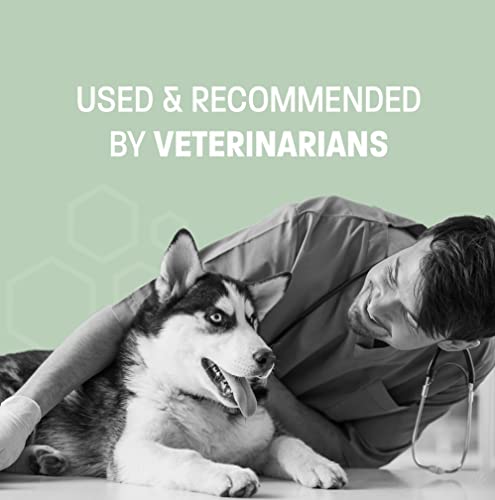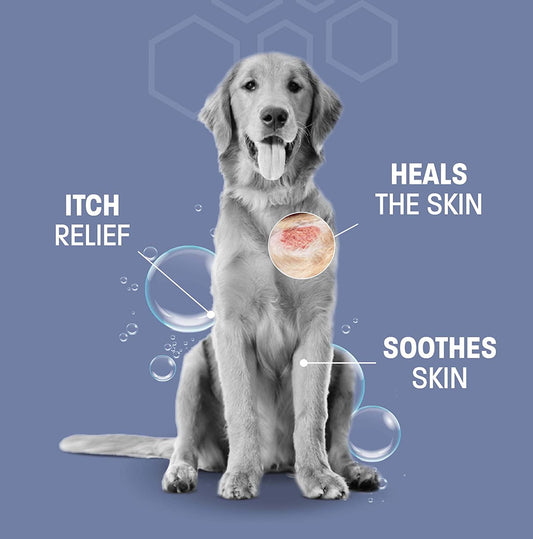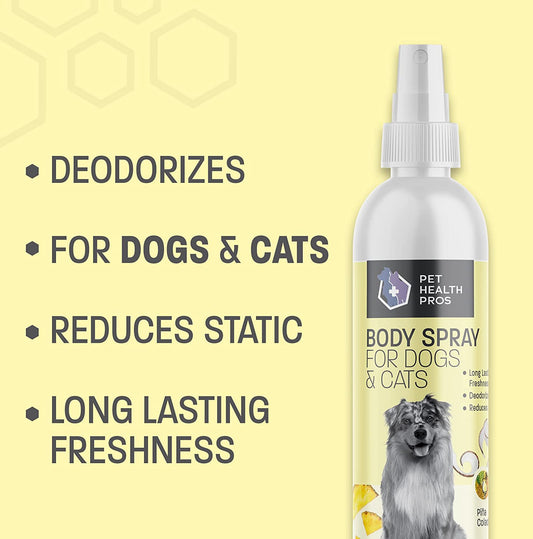Hot spots shouldn't dampen spirits. Learn how Pet Health Pros enhances your dog's comfort and quality of life through its dedicated products.
Hot spots, also called acute moist dermatitis, are skin inflammation and infection that can cause itching, redness, and even hair loss. They are not fully understood, but are linked to underlying issues like allergies, flea infestations, or poor grooming. If untreated, they worsen. To treat them, clean the area with an antiseptic solution. Severe cases may need antibiotics and steroid injections.
Root causes need to be addressed, too. Allergies? Identify and eliminate the allergen. Regular grooming and flea control are important. Certain breeds, such as Golden Retrievers and Saint Bernards, are more prone due to their thick coats.
Early detection and proper care can help prevent these skin conditions from becoming a persistent problem. Good understanding of hot spots is key to providing relief and improving dogs' quality of life.
What Causes Hot Spots in Dogs
Hot spots in dogs are caused by various factors such as allergies, insect bites, and excessive licking/scratching. Left untreated, these areas can become painful and infected. Biting and scratching the skin breaks it, allowing bacteria to settle in.
Allergies may be the root cause of hot spots. Dogs can be allergic to several things - food, environmental allergens (pollen, dust mites), flea bites, etc. Allergies cause an inflammatory response, leading to itching and irritation.
Fleas may also lead to hot spots. Flea bites are itchy for dogs, so they scratch and bite their skin. This constant irritation promotes bacteria growth, resulting in hot spots.
Excessive licking/scratching due to boredom or anxiety can also lead to hot spots. Dogs groom themselves obsessively when stressed or bored. This behavior damages the skin, making it vulnerable to infection.
Pro Tip: To avoid hot spots in your pup, address any allergies/flea infestations. Regular grooming and providing mental stimulation can reduce boredom-related licking/scratching. If you spot any signs of hot spots on your dog's skin, get veterinary treatment immediately for relief and to stop further complications.
Recognizing the Symptoms of Hot Spots
Hot spots on dogs can cause distress and discomfort. Recognizing the symptoms is the first step in providing relief. Here are the key signs to watch for:
- Excessive scratching or licking of a certain area
- Redness, swelling, or oozing of the skin
- Hot and painful patches on the dog's body
- Foul smell coming from the affected areas
- Matted fur or hair loss at a particular spot
- Inflammation and irritation that may make your pup agitated
These symptoms can also point to other skin conditions, so it is important to consult your vet for an accurate diagnosis. To alleviate your dog's discomfort, keep the affected area clean and dry. Wash the hotspot with a mild antiseptic solution recommended by your vet. This prevents bacterial growth and helps healing.
Apply a topical antibiotic ointment or spray as prescribed by your vet. This soothes inflammation and protects against infection. An Elizabethan collar can prevent further itching and scratching. Trim your dog's nails to stop excessive scratching.
Additionally, address any underlying causes like allergies or parasites. This reduces the likelihood of recurrent hot spots. If you recognize the symptoms early and implement these suggestions promptly, you'll restore your pup's comfort in no time. Work closely with your vet for appropriate treatment.
Treatment Options for Hot Spots in Dogs
Your pup's comfort is important! Hot spots can cause distress. To restore their ease, here are some treatments:
- Topical Medications: Medicated creams or sprays on the area can soothe and heal.
- Antibiotics: Severe cases may need oral antibiotics from a vet.
- Cone Collars: Keep the hot spot from being licked or scratched.
- Hydrocortisone Creams: Relieve the itching and inflammation.
- Proper Wound Care: Keep the area clean and dry.
Vets know best - they will make sure your pup gets the right care. Plus, early treatment leads to faster recovery.
Pro Tip: Regular grooming and hygiene help prevent hot spots.
Preventing Hot Spots in Dogs
Groom regularly to keep your pup's skin clean and free from dirt and moisture that may cause hot spots. Additionally, feed them a nutritious diet full of essential fatty acids. Maintain a clean and sanitized environment to avoid bacterial growth.
Plus, keep your canine active and engaged with interactive toys or puzzles. Consulting with your vet for flea and tick control advice is also key. Take action now to give your pup a comfortable and itch-free life!
Remember, prevention is the best way to stave off hot spots. Utilize these preventative measures and seek professional help for optimal health and happiness.
Conclusion: Promoting Your Dog's Comfort and Well-being
Make discomfort a distant memory for your dog. With Pet Health Pros, restore joy and ease to your beloved pet's life.
It's essential to look after your pup's comfort and wellness. Hot spot treatments can help restore their ease and soothe any distress they're dealing with. These treatments range from topical cures to oral medications.
Common hot spot treatments involve medicated shampoos. These are specially formulated to calm irritated skin and speed up healing. Bathe your dog regularly with these shampoos to lessen the severity of hot spots and stop them from occurring again.
You can also use topical sprays and creams to treat hot spots. These contain hydrocortisone or aloe vera to give quick relief from itching and swelling. Apply the products directly to the affected area for immediate comfort.
It's important to identify any underlying causes that may trigger hot spots. Allergies, fleas, or matted fur are usual causes. By finding and fixing these causes, you can stop future outbreaks and improve your dog's overall well-being.
Pro Tip: Regular grooming sessions not only keep their coat healthy, but also prevent hot spots. Brush your pup's fur regularly to remove tangles and mats. Additionally, watch out for any signs of allergies or fleas and speak to your vet for treatment options.
Prioritize your pup's comfort and well-being. Make sure they live a happy and itch-free life. Maintain good hygiene, address underlying causes, and get help from professionals for optimal care for your furry companion.
Frequently Asked Questions
FAQs for the topic 'Quality of Life: Restoring Your Dog’s Comfort with Hot Spots Treatments'
1. What are hot spots in dogs?
Hot spots, also known as acute moist dermatitis, are red, inflamed, and irritated patches of skin that can cause discomfort and pain in dogs. They are often itchy and can appear suddenly due to various reasons such as allergies, insect bites, or excessive licking and scratching.
2. How can I treat hot spots on my dog?
There are several hot spot treatment options for dogs. The first step is to clean the affected area with a mild, pet-safe antiseptic solution. Trim the hair around the hot spot to allow it to breathe and heal faster. You can also apply a topical hot spot remedy recommended by your vet, which may include soothing creams, sprays, or ointments. In severe cases, oral antibiotics or corticosteroids might be prescribed.
3. Are there any home remedies for hot spots in dogs?
While it's important to consult a veterinarian for proper diagnosis and treatment, there are some home remedies that can provide temporary relief for hot spots. These include gently washing the affected area with diluted apple cider vinegar, applying aloe vera gel, or using a cold compress to soothe the itching and reduce inflammation. However, it's crucial to address the underlying cause to prevent recurring hot spots.
4. How long does it take for a hot spot to heal?
The healing time for hot spots can vary depending on the severity and the treatment provided. In mild cases, with proper care and treatment, hot spots can start to heal within a week. However, more severe hot spots may take several weeks to heal completely. It's important to closely monitor your dog's progress and follow your vet's instructions for faster healing.
5. Can hot spots be prevented?
While it may not be possible to prevent hot spots entirely, there are ways to minimize the risk. Regular grooming and maintaining good hygiene help in preventing matting and excessive moisture on the skin. Avoiding common allergens, like certain foods or environmental triggers, can also reduce the likelihood of hot spots. Additionally, keeping your dog's skin healthy by providing a balanced diet and regular exercise contributes to overall skin wellness.
6. When should I seek veterinary care for my dog's hot spots?
If you notice your dog developing hot spots, it's important to consult a veterinarian as soon as possible. They can properly diagnose the underlying cause and recommend suitable treatment options. Seek veterinary care if the hot spot appears to be worsening, if it is accompanied by other symptoms like fever or loss of appetite, or if your dog shows signs of extreme discomfort or pain.








